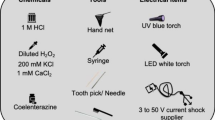Abstract
Growth and emission characteristics of the luminescent bacterium Photobacterium phosphoreum strain KM MGU 331 originating from the White Sea and isolated from the intestine of a bottom-dwelling fish, the European sculpin, Myoxocephalus scorpius, were analyzed. The strain is characterized by a high rate of colony formation and high intensity of light emission on agarized medium at 4° C as well as by highly efficient (5 × 105 quanta s−1 cell−1) and prolonged (over 100 h) light generation upon submerged cultivation at 20°C. The acidic shift of pH in the medium didn’t exceed 0.3 pH units. Effects of temperature, pH, and sodium chloride concentration on emission characteristics of intact photobacterium cells were studied. The optimal temperature for luminescence was found to be 15°C. The maximum luminescence activity was stable in a wide pH range from 7.0 to 9.0. Luminescence occurred within the range of 0.2–3.8% NaCl with the maximum at 2.5%. The results obtained confirm the literature data suggesting that luminescent bacteria adapted to low-temperature conditions possess a highly conjugated system of electron transfer to luciferase.
Similar content being viewed by others
References
Nealson, K.H., and Hastings, J.W., Bacterial Bioluminescence: Its Control and Ecological Significance, Microbiol. Rev., 1979, vol. 43, no. 4, pp. 406–518.
Nealson, K.H., Isolation, Identification, and Manipulation of Luminous Bacteria, Meth. Enzymol., 1978, vol. 57, pp. 153–166.
Gitelson, J.I., Vydryakova, G.A., Kuznetsov, A.M., Rodicheva, E.K., Medvedeva, S.E., and Chugaeva, Yu.V., Luminous Bacteria Culture Collection Biodiversity and Applied aspects, Biolum. Chemilum., Case, J.F., et al., Eds., Singapore: World Sci. Publ. Co., 2000.
Ruby, E.G., and Nealson, K.H., Seasonal Changes in the Species Composition of Luminous Bacteria in the Nearshore Seawater, Luminol. Oceanogr., 1978, vol. 23, pp. 164–169.
Ruby, E.G., Greenberg, E.P., and Hastings, J.W., Planctonic Marine Luminous Bacteria: Species Distribution in the Water Colump, Appl. Environ. Microbiol., 1980, vol. 39, no. 2, pp. 302–306.
Shilo, M., and Yetinson, T., Physiological Characteristics Underlying the Distribution Patterns of Luminous Bacteria in the Mediterranean Sea and the Gulf of Elat, Appl. Environ. Microbiol., 1979, vol. 38, no. 4, pp. 577–584.
Hendrie, M.S., Hodgkiss, W., and Shewan, J.M., Identification, Taxonomy, and Classification of Luminous Bacteria, J. Gen. Microbiol., 1970, vol. 64, pp. 157–169.
Wilson, Th., and Hastings, J.W., Bioluminescence, Annu. Rev. Cell Dev. Biol., 1998, vol. 14, pp. 197–230.
Hastings, J.W., and Nealson, K.H., Bacterial Bioluminescence, Annu. Rev. Microbiol., 1977, vol. 31, pp. 549–595.
Watanabe, T., and Nakamura, T., Bioluminescence and Cell Growth of Photobacterium phosphoreum, J. Biochem., 1980, vol. 88, no. 3, pp. 815–817.
Johnson, F.H., Eyring, H., Steblye, R., Chaplin, H., Huber, C., and Gherardi, G., The Nature and Control of Reactions in Bioluminescence, J. Gen. Physiol., 1945, vol. 28, no. 5, pp. 463–537.
Cline, T.W., Isolation and Characterisation of Luminescence System Mutants in Bacteria, Meth. Enzymol., 1978, vol. 57, pp. 166–171.
Waters, P., and Lloyd, D., Salt, pH, and Temperature Dependencies of Growth and Bioluminescence of Three Species of Luminous Bacteria Analysed on Gradient Plates, J. Gen. Microbiol., 1985, vol. 11, no. 131, pp. 2865–2869.
Hastings, J.W., and Weber, G., Total Quantum Flux of Isotropic Sources, Opt. Soc. Am., 1963, vol. 53, no. 12, pp. 1410–1415.
Watanabe, H., Mimura, M., Takimoto, A., and Nakamura, T., Luminescence and Respiratory Activities of Photobacterium phosphoreum, J. Biochem., 1975, vol. 77, no. 6, pp. 1147–1155.
Lee, B., Lee, J., Shin, D., and Kim, E., Statistical Optimization of Bioluminescence Photobacterium phosphoreum KCTC 2852, Environ. Int., 2006, vol. 32, no. 2, pp. 265–268.
Nealson, K.H., Platt, T., and Hastings, J.W., The Cellular Control of the Synthesis and Activity of the Bacterial Luminescent System, J. Bacteriol., 1970, vol. 104, no. 3, pp. 313–322.
Ulitzur, S., and Hastings, J.W., Growth, Luminescence Respiration, and the Adenosine Triphosphate Pool in Beneckea harveyi, J. Bact., 1978, vol. 133, pp. 1307–1313.
Makiguchi, N., Arita, M., and Asai, Y., Optimum Cultural Conditions for Strong Light Production by Photobacterium phosphoreum, J. Gen. Appl. Microbiol., 1980, vol. 26, no. 2, pp. 75–83.
Author information
Authors and Affiliations
Corresponding author
Additional information
Original Russian Text © V.V. Kuts, A.D. Ismailov, 2009, published in Mikrobiologiya, 2009, Vol. 78, No. 5, pp. 612–617.
Rights and permissions
About this article
Cite this article
Kuts, V.V., Ismailov, A.D. Physiological and emission characteristics of the luminescent bacterium Photobacterium Phosphoreum from the White Sea. Microbiology 78, 554–558 (2009). https://doi.org/10.1134/S002626170905004X
Received:
Published:
Issue Date:
DOI: https://doi.org/10.1134/S002626170905004X




